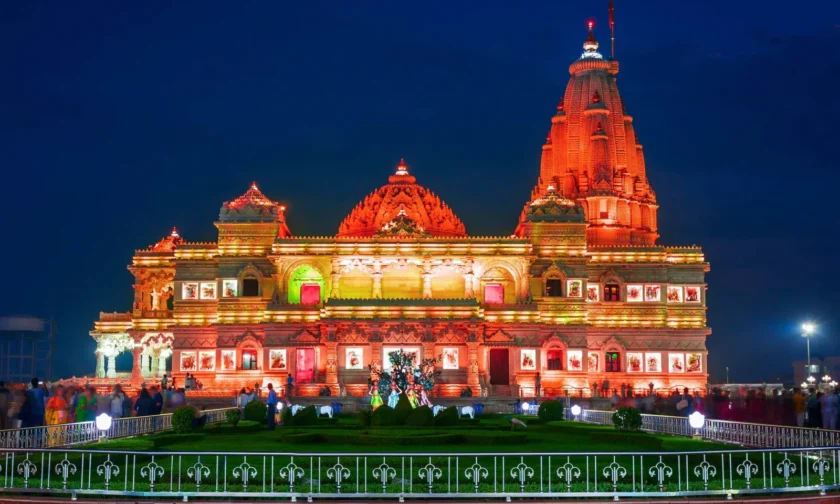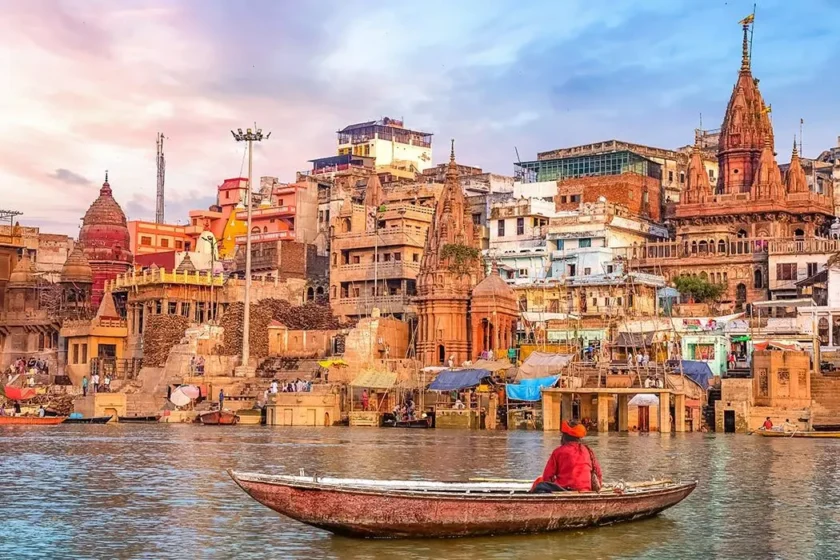Ayodhya: Standing majestically on the banks of the Saryu River, the Ram Mandir in Ayodhya is more than just a temple—it is a symbol of faith, resilience, and cultural revival. Completed in full grandeur by mid-2025, following its inauguration on January 22, 2024, the temple has transformed Ayodhya into a global spiritual beacon. Where history once echoed with contention, now reverberates devotion, attracting millions and positioning Uttar Pradesh as India’s foremost religious tourism hub.
A Temple Reborn, A State Transformed
Prime Minister Narendra Modi captured the essence during the Pran Pratishtha ceremony: “Ram is not the problem, but the solution.” These words resonate not only in the spiritual realm but in the corridors of economic policy, signaling a new era where faith and prosperity walk hand in hand.
A Dream Realised: The Making of the Ram Mandir
The Ram Mandir, after centuries of anticipation, is a marvel of modern engineering and traditional artistry. According to Nripendra Mishra, Chairman of the Ram Mandir Construction Committee, the final touches, including the intricate Makrana marble statues and the circumambulation path, were completed by September 2025. The temple’s full readiness ensures devotees can experience seamless darshan, a factor crucial to sustaining tourism momentum.
The architectural brilliance reflects both devotion and innovation. Towers reach skyward, echoing stories from the Ramayana, while expansive courtyards and intricately carved pillars blend timeless craftsmanship with modern accessibility. For pilgrims, the temple is not merely a religious site—it is a journey into history, mythology, and spiritual consciousness.
Faith Meets Footfall: A Tourism Boom Like Never Before
Ayodhya is witnessing an unprecedented influx of visitors. In 2024 alone, the city welcomed 135.5 million domestic tourists and over 3,100 international visitors, surpassing even the Taj Mahal’s footfall of 125.1 million. Overall, Uttar Pradesh recorded 476.1 million visitors from January to September 2024—a staggering 70% surge in religious tourism. Experts project 50–100 million annual visitors to Ayodhya by 2025, putting it on par with global pilgrimage destinations like the Vatican and Mecca.
This surge is more than numbers—it is a testament to faith-driven travel becoming a cornerstone of Uttar Pradesh’s identity. Tourism Minister Jaiveer Singh highlights: “Uttar Pradesh welcomed 48 crore tourists last year, a milestone nearly reached in just nine months this year.” For pilgrims, the experience is amplified by modern infrastructure, guided tours, and the spiritual energy that permeates the city.
Economic Ripple Effect: From Pilgrims to Prosperity
The Ram Mandir’s impact extends far beyond spiritual inspiration. A State Bank of India (SBI) report estimates that tourist expenditure in Uttar Pradesh will surpass ₹4 lakh crore by the end of FY25, nearly doubling the ₹2.3 lakh crore recorded in 2022. This influx is projected to generate an additional ₹25,000 crore in tax revenue, fortifying Uttar Pradesh’s path to a $500 billion economy by FY28.
Chief Minister Yogi Adityanath emphasizes this synergy of devotion and development: “With the growth in tourism, Uttar Pradesh will become richer by about 4 lakh crores this year.” GST collections from Ayodhya alone hit ₹1 crore in just nine months of 2025, while traders earned ₹3,000 crore during high-profile events like the Mahakumbh.
Infrastructure Revolution: Building a Global-Scale Pilgrimage City
To accommodate this surge, the state has invested ₹85,000 crore into Ayodhya’s redevelopment. This includes a $10 billion makeover, featuring a new international airport, revamped railway station, widened highways, and upgraded public transit. Vande Bharat and Amrit Bharat trains now connect Delhi to Ayodhya in under six hours, while 50 electric buses and 25 green autos ply city routes, reflecting a commitment to sustainability.
Iconic roads such as Ram Path and Bhakti Path, spanning 13 km, blend heritage with modernity, guiding visitors through sacred and scenic zones. Tourism Minister Singh underscores that these upgrades are not cosmetic: “We are ensuring that tourism growth translates into sustainable economic benefits for the state.”
A Connected Spiritual Circuit: Ayodhya to Kashi to Mathura
The Ram Mandir’s influence is creating a halo effect across Uttar Pradesh. The state’s spiritual circuit now forms a seamless pilgrimage route: from Ayodhya to Varanasi’s Kashi Vishwanath Corridor, Mathura-Vrindavan, and Prayagraj’s Triveni Sangam. In 2024, Varanasi saw 62 million visitors, Mathura 45 million, and Prayagraj 48 million—numbers amplified by Ayodhya’s gravitational pull.
Hospitality expert Rohit Malhotra notes, “The government’s focus on upgrading tourist facilities has been commendable. From premium hotels to guided tours and seamless transport, Uttar Pradesh now offers a holistic travel experience.” Over 50 luxury hotels are slated to open in Ayodhya alone, with chains like OYO planning 150 more across the state, creating both beds and jobs.
Opportunities for All: Artisans, Women, Youth, Entrepreneurs
Tourism is weaving itself into the social fabric of Uttar Pradesh. Local artisans, previously sidelined, are thriving on demand for Ram-themed handicrafts, while women-led cooperatives manage homestays and eco-tours. Small vendors report 300% sales spikes during peak seasons, from Deepotsav’s 2.28 million diyas to Ram Navami’s 22 crore pilgrims in 2025—six crore more than the previous year.

Niranjan Hiranandani, Founder of Hiranandani Group, captures the optimism: “Ayodhya’s entrepreneurs and businesses now have ample opportunities to meet the growing demand for goods and services. Combined with the cultural and emotional significance, this economic stimulus will bolster Uttar Pradesh’s GDP.” The state’s tourism-led revival is tangible, from handicraft markets to local eateries, reinforcing the mantra: faith fuels growth.
Voices from the Ground
Across Ayodhya, the energy is palpable. Sita Devi, a local homestay owner, beams: “Our bookings have quadrupled since the temple opened. Tourists are coming from all over India and even abroad. This is life-changing for families like ours.” Pilgrims echo similar awe: “Standing before the temple, you feel centuries of devotion in every stone,” says Ramesh Gupta from Lucknow.
Government officials, too, are optimistic. Shrikant Sharma, UP Minister in 2020, foresaw: “The Ram temple will not only give a boost to tourism but generate employment opportunities as well.” Today, that prophecy is unfolding, with multi-sector growth catalyzed by faith-driven tourism.
Challenges on the Path to Glory
Yet, such unprecedented tourism brings challenges. Daily crowds can reach 500,000 post-inauguration, necessitating robust crowd control, waste management, and water security measures. Environmentalists caution against overburdening the Saryu River, advocating solar-powered boats and green pathways, initiatives piloted by the Uttar Pradesh New and Renewable Energy Agency.
Inclusivity is also critical. While domestic pilgrims dominate, international outreach via multilingual apps, visa facilitation, and global marketing could double foreign footfall. Balancing spiritual reverence with mass tourism is delicate, but Uttar Pradesh appears poised to manage both.
The Digital & Global Push
Social media amplifies the Ram Mandir’s dual role as spiritual anchor and economic engine. On X (formerly Twitter), users celebrate: “Eight years of transformative growth… Shri Ram Mandir, Kashi Vishwanath Corridor are redefining tourism, heritage, and spirituality.” Posts envision a “new era of heritage tourism,” with Ayodhya’s 22 crore visitors in 2025 silencing skeptics and attracting global attention.
Global investors are circling. In Ayodhya alone, 102 MoUs worth ₹18,000 crore have been signed, attracting marquee names like Adani and Tata. According to SBI, this “road to salvation” merges devotional fervor with international business acumen, creating a blueprint for sustainable pilgrimage-led development.
The Road Ahead: Investment, Innovation & International Recognition
Looking ahead, Uttar Pradesh anticipates 65 crore tourists in 2025, with continued investment in hotels, heritage walks, and transportation. Infrastructure and technology upgrades—such as multilingual apps, solar-powered amenities, and streamlined ticketing—ensure that growth is not just quantitative but qualitative.
The Ram Mandir is also redefining Uttar Pradesh’s global image. By blending centuries-old devotion with contemporary management practices, the state positions itself as a model for religious tourism worldwide—a fusion of Latin American vibrancy with Scandinavian efficiency, as one analyst aptly described.
A New Dawn for Uttar Pradesh
Ultimately, the Ram Mandir is more than stone and sanctity. It is a catalyst for transformation, breathing new life into Ayodhya and reverberating across Uttar Pradesh. Faith has forged opportunity: from quiet hamlets to bustling bazaars, from artisans to entrepreneurs, the state hums with renewed energy. Each pilgrim, each rupee, and each dream contributes to a thriving socio-economic ecosystem.
As Ayodhya awakens fully in 2025, Uttar Pradesh does not merely host tourists—it inspires a nation. The temple’s grandeur is matched only by the optimism it engenders, symbolizing a future where devotion and development converge. In the words of local devotees and policymakers alike, “Here, the divine builds prosperity.”
Jai Shri Ram.






